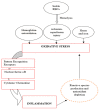A Review of the Relationship between the Immune Response, Inflammation, Oxidative Stress, and the Pathogenesis of Sickle Cell Anaemia
- PMID: 37760854
- PMCID: PMC10525295
- DOI: 10.3390/biomedicines11092413
A Review of the Relationship between the Immune Response, Inflammation, Oxidative Stress, and the Pathogenesis of Sickle Cell Anaemia
Abstract
Sickle cell anaemia (SCD) is a life-threatening haematological disorder which is predominant in sub-Saharan Africa and is triggered by a genetic mutation of the β-chain haemoglobin gene resulting in the substitution of glutamic acid with valine. This mutation leads to the production of an abnormal haemoglobin molecule called haemoglobin S (HbS). When deoxygenated, haemoglobin S (HbS) polymerises and results in a sickle-shaped red blood cell which is rigid and has a significantly shortened life span. Various reports have shown a strong link between oxidative stress, inflammation, the immune response, and the pathogenesis of sickle cell disease. The consequence of these processes leads to the development of vasculopathy (disease of the blood vessels) and several other complications. The role of the immune system, particularly the innate immune system, in the pathogenesis of SCD has become increasingly clear in recent years of research; however, little is known about the roles of the adaptive immune system in this disease. This review examines the interaction between the immune system, inflammation, oxidative stress, blood transfusion, and their effects on the pathogenesis of sickle cell anaemia.
Keywords: blood transfusion; chronic inflammation; haemolysis; immune system; oxidative stress; sickle cell anaemia.
Conflict of interest statement
The authors declare no conflict of interest.
Figures
Similar articles
-
Novel approaches to treatment of sickle cell anaemia.Expert Opin Investig Drugs. 1999 Nov;8(11):1823-1836. doi: 10.1517/13543784.8.11.1823. Expert Opin Investig Drugs. 1999. PMID: 11139827
-
The Red Blood Cell-Inflammation Vicious Circle in Sickle Cell Disease.Front Immunol. 2020 Mar 13;11:454. doi: 10.3389/fimmu.2020.00454. eCollection 2020. Front Immunol. 2020. PMID: 32231672 Free PMC article. Review.
-
Recommendations for the use of red blood cell exchange in sickle cell disease.Transfus Apher Sci. 2019 Apr;58(2):128-131. doi: 10.1016/j.transci.2019.03.004. Epub 2019 Mar 13. Transfus Apher Sci. 2019. PMID: 30879904 Review.
-
Oxidative profile of sickle cell patients in a Cameroonian urban hospital.BMC Clin Pathol. 2016 Sep 21;16:15. doi: 10.1186/s12907-016-0037-5. eCollection 2016. BMC Clin Pathol. 2016. PMID: 27688734 Free PMC article.
-
An Assessment of Knowledge, Awareness, and Attitude of Undergraduates toward Sickle Cell Disease in Lagos, Nigeria.Niger Med J. 2017 Nov-Dec;58(6):167-172. doi: 10.4103/nmj.NMJ_111_18. Niger Med J. 2017. PMID: 31198270 Free PMC article.
Cited by
-
Crosstalk Between Sickle Cell Disease and Ferroptosis.Int J Mol Sci. 2025 Apr 13;26(8):3675. doi: 10.3390/ijms26083675. Int J Mol Sci. 2025. PMID: 40332185 Free PMC article. Review.
-
Profiles of systemic lupus erythematosus patients with co-existing sickle cell disease: a coincidence or true association?Reumatologia. 2024;62(6):430-438. doi: 10.5114/reum/195432. Epub 2024 Dec 24. Reumatologia. 2024. PMID: 39866301 Free PMC article.
-
Understanding and treating menstruation associated sickle cell pain.Contracept Reprod Med. 2025 Apr 3;10(1):27. doi: 10.1186/s40834-025-00361-8. Contracept Reprod Med. 2025. PMID: 40181434 Free PMC article. Review.
-
Ferroptosis as an emerging target in sickle cell disease.Curr Res Toxicol. 2024 Jun 18;7:100181. doi: 10.1016/j.crtox.2024.100181. eCollection 2024. Curr Res Toxicol. 2024. PMID: 39021403 Free PMC article.
-
Sickle Cell Disease Update: New Treatments and Challenging Nutritional Interventions.Nutrients. 2024 Jan 15;16(2):258. doi: 10.3390/nu16020258. Nutrients. 2024. PMID: 38257151 Free PMC article. Review.
References
-
- Adesina O.A., Opesade A.O. Bibliometirc Analysis of Sickle Cell Anaemia Literature on Nigeria Listed in Pubmed between 2006 and 2016. Libr. Philos. Pract. 2018:1–16.
-
- Fraiwan A., Hasan M.N., An R., Rezac A.J., Kocmich N.J., Oginni T., Olanipekun G.M., Hassan-Hanga F., Jibir B.W., Gambo S., et al. Advancing healthcare outcomes for sickle cell disease in Nigeria using mobile health tools. Blood. 2019;134:2173. doi: 10.1182/blood-2019-131344. - DOI
Publication types
LinkOut - more resources
Full Text Sources




